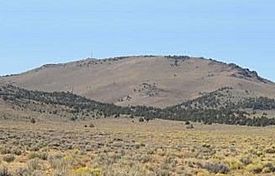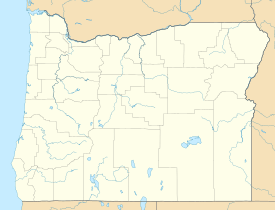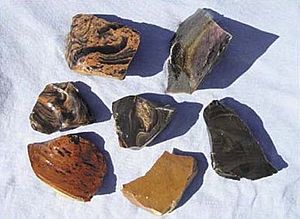Glass Buttes facts for kids
Quick facts for kids Glass Buttes |
|
|---|---|

Glass Buttes are a high desert landmark
|
|
| Highest point | |
| Elevation | 6,385 ft (1,946 m) |
| Prominence | 2,000 ft (610 m) |
| Geography | |
| Location | Lake County, Oregon, US |
| Topo map | USGS Glass Butte |
| Geology | |
| Age of rock | 5 to 5.8 million years |
| Mountain type | Silicic domes |
| Climbing | |
| Easiest route | Rough dirt road |
Glass Buttes are a group of volcanic mountains. They have two main peaks and many smaller hills. You can find them in a quiet part of Lake County, Oregon, USA. They are between the cities of Bend and Burns.
These mountains stand tall above the high desert. They were once a key landmark in an area called Oregon's Great Sandy Desert. They are named Glass Buttes because of all the obsidian (a type of natural glass) found there. Most of the land around Glass Buttes is managed by the Bureau of Land Management. It's a great place for fun activities like collecting rocks, hiking, camping, and hunting.
Contents
Where Are Glass Buttes and How They Formed?
Glass Buttes are in Oregon's high desert. They are about 70 miles (110 km) southeast of Bend. They are also about 50 miles (80 km) west of Burns. The closest small town is Hampton, about 10 miles (16 km) away.
The Peaks of Glass Buttes
The Glass Buttes area has two main peaks and many smaller hills. The highest point is called Glass Butte. It stands 6,388 feet (1,947 meters) above sea level. The mountains are steep with large basalt rocks scattered on their sides. There is another peak to the southeast called Little Glass Butte. It is 6,155 feet (1,876 meters) high. These buttes are important landmarks. They rise about 2,000 feet (610 meters) above the flat desert.
How Glass Buttes Were Made
Glass Buttes were formed a very long time ago. This was about 5 to 5.8 million years ago. They are what's left of old silicic volcanoes. Over time, wind and water have worn them down.
The mountains were created by three periods of lava flows. First, there were basalt lava flows. Then, rhyolitic lava flowed. Finally, more basalt flows covered everything. The main rock in the mountains is rhyolite. In some spots, hot water from underground has changed the rocks. You can also find minerals like cinnabar, alunite, hematite, hyalite, and pyrite here.
Plants and Animals of Glass Buttes
Glass Buttes is part of Oregon's high desert. The area around the buttes is very dry. There is little or no natural water for most of the year. This region was once known as Oregon's Great Sandy Desert.
Desert Plants
The ground on the mountain slopes is mostly covered with sagebrush. You can also see green rabbitbrush and mountain mahogany. Grasses like Idaho fescue and bluebunch wheatgrass grow here too.
On the north and west sides of the mountains, you'll find western juniper trees. Some small pine groves also grow in canyons. Under these trees, there is more sagebrush and mountain mahogany. In areas where water flows sometimes, you might even spot willow trees.
Desert Animals
Many different animals live around Glass Buttes. Large animals include pronghorn, mule deer, and elk. You might also see coyotes, bobcats, and cougars.
Smaller animals are common too. These include American badgers, striped skunks, and different types of rabbits. There are also many kinds of squirrels, chipmunks, and mice. Rattlesnakes and several types of lizards live in the area.
Birds of the Buttes
Many birds call Glass Buttes home. You can find sagebrush sparrows, lark sparrows, and Brewer's sparrows. Other birds include mountain bluebirds, green-tailed towhees, and sage thrashers. Brewer's blackbirds and black-billed magpies are also common.
The Glass Buttes area is a great home for greater sage-grouse. Larger birds like barn owls and great horned owls live here. You might also spot prairie falcons, red-tailed hawks, turkey vultures, and golden eagles flying overhead.
A Look at Glass Buttes History
For thousands of years, Native Americans used obsidian from Glass Buttes. They made sharp tools, arrowheads, and spear points. Obsidian was also important for trading with other tribes. People used Glass Buttes obsidian at least 9,000 years ago. Some experts think Clovis people might have collected it even 13,000 years ago.
Glass Buttes obsidian has been found far away. It has been found in places like British Columbia to the north and California to the south. It has also been found as far east as Idaho. Some reports even say it was found at archeological sites in Ohio.
Early Settlers and Mining
In the early 1900s, American homesteaders started to settle near Glass Buttes. Most arrived between 1910 and 1913. The only small community was Stauffer. It was just south of Glass Buttes. Settlers used juniper logs from the buttes to build their homes. They also decorated their homes with obsidian. By 1918, many homesteads were left empty. This was due to tough economic times and not enough water for farm animals.
In the 1930s, a local rancher named Percy L. Forbes studied the obsidian and minerals. In 1934, a newspaper reported his findings. He found many obsidian sites and identified seven types of natural glass. His discoveries included a special rainbow-colored obsidian. It had bands of blue, green, red, pink, and gold. This type was unique to Glass Buttes.
Mercury was mined in Glass Buttes from the mid-1940s to the early 1960s. Percy L. Forbes first found these mercury deposits in 1933. By 1957, there were 25 mining claims. The largest mine produced a lot of mercury each month. However, mining mercury was expensive. The mines closed by 1961 because the price of mercury dropped too low.
Modern Energy and Roads
In 2009, a company leased land around Glass Buttes. They wanted to explore for geothermal energy. Geologists thought they could find very hot water deep underground. This project involved building roads and drilling wells. An environmental study was finished in 2013. The Bureau of Land Management then approved seven test wells. If the water is hot enough, it can be used to make electricity.
Today, a rough road goes to the top of Glass Butte. This road leads to several communication towers at the summit. In 2015, the Oregon Department of Transportation started to fix parts of the state's radio network. This network is used by the transportation department and the Oregon State Police. Work on the Glass Butte towers began in 2016.
Fun Things to Do at Glass Buttes
The Glass Buttes area offers many fun activities. These include rock collecting, hiking, camping, hunting, and studying nature. Rock collecting is the most popular activity.
Collecting Obsidian
Glass Buttes has one of the largest and most varied obsidian deposits in the world. The mountains are named for all the obsidian found on their slopes. You can find many types of beautiful, high-quality obsidian here. Some types include jet black, brown, green, red fire, pumpkin, mahogany, and rainbow obsidian. There are also gold sheen, silver sheen, and snowflake varieties.
Some rockhounds like to dig for special obsidian pieces. But there are also large fields of colorful obsidian right on the ground. This makes it easy to collect.
Rules for Collecting
Most of the land at Glass Buttes is owned by the United States Government. The Department of Interior's Bureau of Land Management manages these lands. Because there is so much good obsidian, the Bureau of Land Management has set aside 36 square miles (93 km2) as a free-use area. Here, people can collect obsidian for their own use.
You do not need a permit to collect obsidian. However, each person can only take 250 pounds (113 kg) of obsidian per year. There are also some state-owned lands and private obsidian claims. These areas are usually not open to the public.
Important Tips for Visitors
The Glass Buttes area is very remote and rugged. The roads are not kept up, so a four-wheel drive vehicle is best. Also, the scattered obsidian can cause flat tires. It is usually very dry here. But if it rains, the roads can quickly become impossible to drive on, even with a four-wheel drive.
There are no developed campsites or other facilities. However, you can camp in many places. In the summer, it's a good idea to check with the Prineville Bureau of Land Management office. They can tell you about any fire restrictions before you visit.



